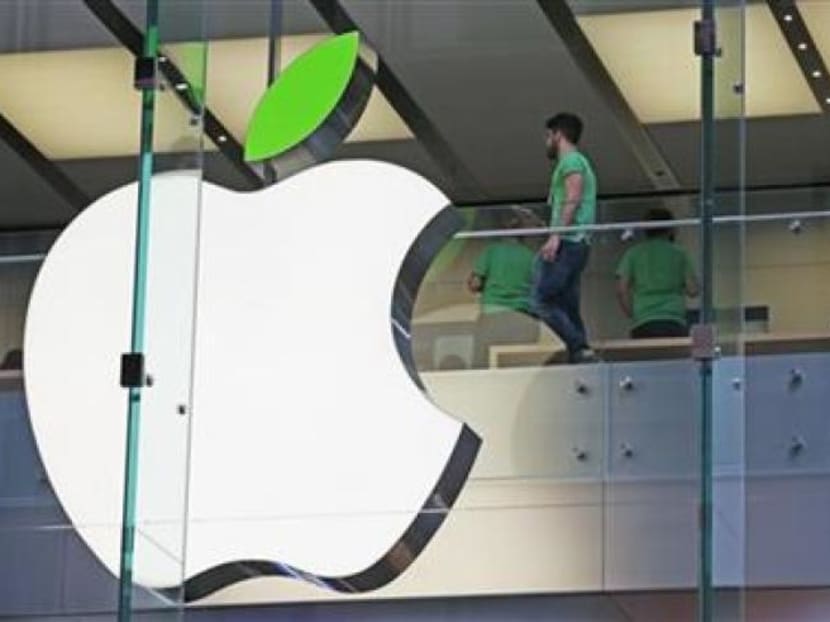Apple digs in on green with China solar, US forest projects
PALO ALTO (CALIFORNIA) — In a quest to be more green, Apple says it is investing in Chinese solar power and preserving forests that make environmentally friendly paper.

Employees wear green shirts near Apple's familiar logo displayed with a green leaf at the Apple Store timed to coincide with an annual celebration of Earth Day in Sydney on April 22 last year. Photo: AP
PALO ALTO (CALIFORNIA) — In a quest to be more green, Apple says it is investing in Chinese solar power and preserving forests that make environmentally friendly paper.
The initiatives come as the tech giant this year met a self-imposed goal of powering all its US operations with renewable energy to reduce carbon emissions — initiatives that have won high marks from environmental groups.
Yesterday (April 16), Apple announced a new focus on using paper from trees harvested under environmentally sound conditions. It is also promising to use more renewable power overseas, where Apple relies heavily on contract manufacturers — and where a top executive acknowledged the company can do more.
“It’s important to us to tackle climate change everywhere we are,” Ms Lisa Jackson, Apple’s Vice President for environmental initiatives, told The Associated Press. “When you talk about China, you’re talking about manufacturing partners. We’re looking to bring the same innovation there. This is the start.”
The new solar project in China has a capacity of 40MW, which is smaller than some projects Apple has announced in the US. By comparison, Apple is spending US$850 million (S$1.14 billion) for rights to nearly half the output of a 280MW solar facility planned for construction south of Apple’s Cupertino, California, headquarters. That project will produce enough energy to power all of Apple’s California offices, a computer centre and 52 retail stores.
Still, the Chinese project will produce more than the amount of energy consumed by Apple’s 19 corporate offices and 21 retail stores in China and Hong Kong, Ms Jackson said. She added that Apple uses renewable energy for 87 per cent of the power at its facilities worldwide.
That figure, however, does not include substantial power consumption by contract manufacturers. With the new project in China, Apple is looking to improve its own operations first.
“Before we go somewhere else and start asking and eventually requiring clean energy, you want to make sure you show folks how to do it,” said Ms Jackson, who was US Environmental Protection Agency administrator during President Barack Obama’s first term.
Apple and other tech companies have drawn criticism in the past for use of toxics in manufacturing and data centres powered by electricity from coal but Apple’s moves away from those practices in recent years have won accolades from groups like Greenpeace, which issued a statement praising the Chinese project yesterday.
Ms Jackson declined to say how much Apple is investing in the Chinese project, which is being built in partnership with US energy company SunPower and four Chinese firms. Although China is known for heavy reliance on coal, its government has set aggressive goals for solar, wind and hydroelectric power.
Meanwhile, Apple pledged an unspecified amount of money for a Virginia-based nonprofit, the Conservation Fund, to purchase two large tracts of timberland on the East Coast. The Conservation Fund will resell the land — 36,000 acres of timberland in Maine and North Carolina — to commercial interests under legally binding terms that require future owners to preserve the forest and follow environmentally sound principles for cutting and replanting trees.
Mr Larry Selzer, the group’s chief executive, said that will protect the forest while keeping it in the hands of private owners who pay taxes and create jobs. Mr Selzer said he will use proceeds from reselling the land to buy and protect additional tracts.
Apple will not necessarily buy paper made from trees on that land, but Ms Jackson said the investment will increase the supply of sustainable wood fibre. She said the two tracts would produce about half the non-recycled wood fibre used in Apple’s product packaging last year.
That would put Apple halfway toward its goal of obtaining all its non-recycled paper products from sustainable timber. Apple would not say how much paper it uses but it says two-thirds of its paper packaging comes from recycled material. In the last three months of last year, Apple sold more than 100 million iPhones and other gadgets, most in cardboard boxes. AP





